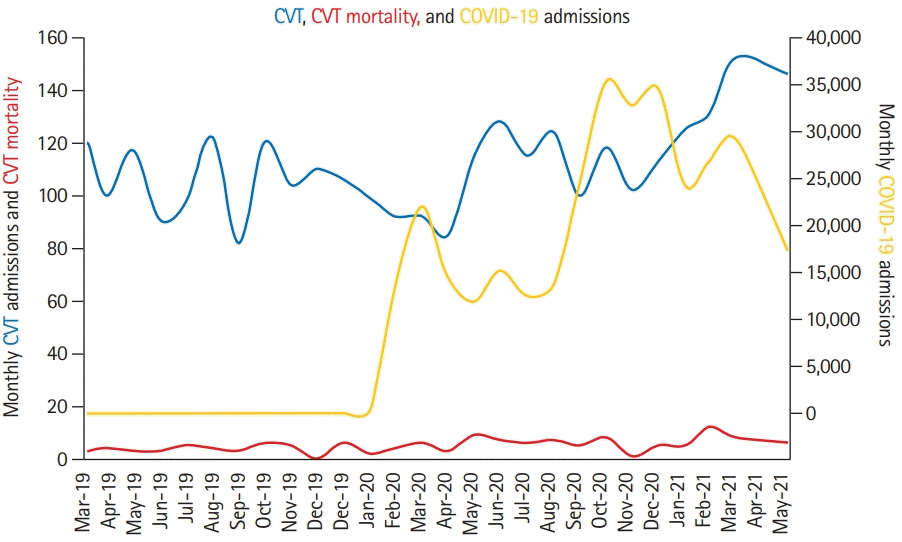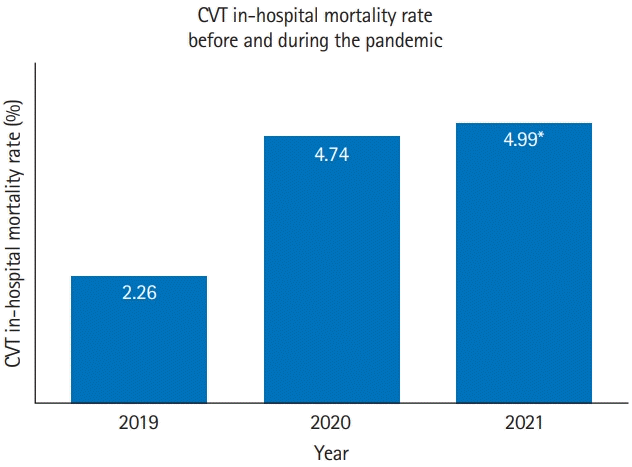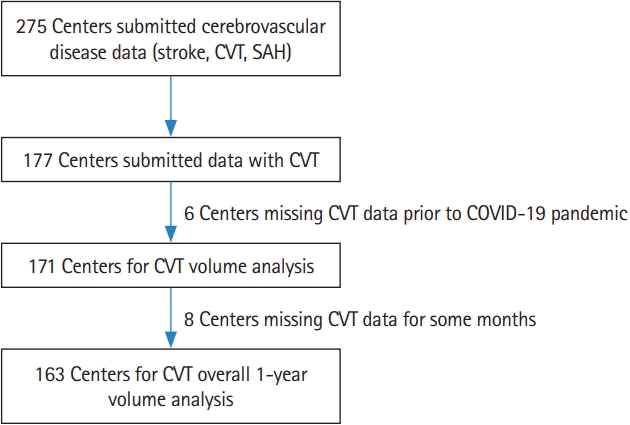1. Ahmad FB, Anderson RN. The leading causes of death in the US for 2020. JAMA. 2021; 325:1829–1830.

2. Chou SH, Beghi E, Helbok R, Moro E, Sampson J, Altamirano V, et al. Global incidence of neurological manifestations among patients hospitalized with COVID-19: a report for the GCS-NeuroCOVID Consortium and the ENERGY Consortium. JAMA Netw Open. 2021; 4:e2112131.
3. Spudich S, Nath A. Nervous system consequences of COVID-19. Science. 2022; 375:267–269.

4. Elkind MSV, Boehme AK, Smith CJ, Meisel A, Buckwalter MS. Infection as a stroke risk factor and determinant of outcome after stroke. Stroke. 2020; 51:3156–3168.

5. Yaghi S, Ishida K, Torres J, Mac Grory B, Raz E, Humbert K, et al. SARS-CoV-2 and stroke in a New York healthcare system. Stroke. 2020; 51:2002–2011.

6. Siegler JE, Cardona P, Arenillas JF, Talavera B, Guillen AN, Chavarría-Miranda A, et al. Cerebrovascular events and outcomes in hospitalized patients with COVID-19: the SVIN COVID-19 Multinational Registry. Int J Stroke. 2021; 16:437–447.

7. Esenwa C, Cheng NT, Luna J, Willey J, Boehme AK, KirchoffTorres K, et al. Biomarkers of coagulation and inflammation in COVID-19-associated ischemic stroke. Stroke. 2021; 52:e706–e709.

8. Ma A, Kase CS, Shoamanesh A, Abdalkader M, Pikula A, Sathya A, et al. Stroke and thromboprophylaxis in the era of COVID-19. J Stroke Cerebrovasc Dis. 2021; 30:105392.

9. Abdalkader M, Shaikh SP, Siegler JE, Cervantes-Arslanian AM, Tiu C, Radu RA, et al. Cerebral venous sinus thrombosis in COVID-19 patients: a multicenter study and review of literature. J Stroke Cerebrovasc Dis. 2021; 30:105733.

10. Rana A, Nguyen TN, Siegler JE. Stroke and neurointervention in the COVID-19 pandemic: a narrative review. Expert Rev Med Devices. 2021; 18:523–531.

11. Devasagayam S, Wyatt B, Leyden J, Kleinig T. Cerebral venous sinus thrombosis incidence is higher than previously thought: a retrospective population-based study. Stroke. 2016; 47:2180–2182.

12. Otite FO, Patel S, Sharma R, Khandwala P, Desai D, Latorre JG, et al. Trends in incidence and epidemiologic characteristics of cerebral venous thrombosis in the United States. Neurology. 2020; 95:e2200–e2213.

13. Coutinho JM, Zuurbier SM, Aramideh M, Stam J. The incidence of cerebral venous thrombosis: a cross-sectional study. Stroke. 2012; 43:3375–3377.
14. Yaghi S, Shu L, Bakradze E, Salehi Omran S, Giles JA, Amar JY, et al. Direct oral anticoagulants versus warfarin in the treatment of cerebral venous thrombosis (ACTION-CVT): a multicenter international study. Stroke. 2022; 53:728–738.
15. Alimohammadi A, Kim DJ, Field TS. Updates in cerebral venous thrombosis. Curr Cardiol Rep. 2022; 24:43–50.

16. Klein P, Shu L, Nguyen TN, Siegler JE, Salehi Omran S, Simpkins A, et al. Factors associated with adverse outcomes following CVT: analysis of ACTION-CVT. Eur Stroke J. 2022; 7(1 Suppl):98.
17. Al-Mufti F, Amuluru K, Sahni R, Bekelis K, Karimi R, Ogulnick J, et al. Cerebral venous thrombosis in COVID-19: a New York Metropolitan Cohort Study. AJNR Am J Neuroradiol. 2021; 42:1196–1200.

18. Sánchez van Kammen M, Heldner MR, Brodard J, Scutelnic A, Silvis S, Schroeder V, et al. Frequency of thrombocytopenia and platelet factor 4/heparin antibodies in patients with cerebral venous sinus thrombosis prior to the COVID-19 pandemic. JAMA. 2021; 326:332–338.

19. Siegler JE, Klein P, Yaghi S, Vigilante N, Abdalkader M, Coutinho JM, et al. Cerebral vein thrombosis with vaccineinduced immune thrombotic thrombocytopenia. Stroke. 2021; 52:3045–3053.

20. Sánchez van Kammen M, Aguiar de Sousa D, Poli S, Cordonnier C, Heldner MR, van de Munckhof A, et al. Characteristics and outcomes of patients with cerebral venous sinus thrombosis in SARS-CoV-2 vaccine-induced immune thrombotic thrombocytopenia. JAMA Neurol. 2021; 78:1314–1323.
21. Perry RJ, Tamborska A, Singh B, Craven B, Marigold R, Arthur-Farraj P, et al. Cerebral venous thrombosis after vaccination against COVID-19 in the UK: a multicentre cohort study. Lancet. 2021; 398:1147–1156.

22. Nogueira RG, Abdalkader M, Qureshi MM, Frankel MR, Mansour OY, Yamagami H, et al. Global impact of COVID-19 on stroke care. Int J Stroke. 2021; 16:573–584.
23. Nogueira RG, Qureshi MM, Abdalkader M, Martins SO, Yamagami H, Qiu Z, et al. Global impact of COVID-19 on stroke care and IV thrombolysis. Neurology. 2021; 96:e2824–e2838.
24. Raymaekers V, Demeestere J, Bellante F, De Blauwe S, De Raedt S, Dusart A, et al. The impact of COVID-19 on acute stroke care in Belgium. Acta Neurol Belg. 2021; 121:1251–1258.

25. Sacco S, Ricci S, Ornello R, Eusebi P, Petraglia L, Toni D, et al. Reduced admissions for cerebrovascular events during COVID-19 outbreak in Italy. Stroke. 2020; 51:3746–3750.
26. Seiffert M, Brunner FJ, Remmel M, Thomalla G, Marschall U, L’Hoest H, et al. Temporal trends in the presentation of cardiovascular and cerebrovascular emergencies during the COVID-19 pandemic in Germany: an analysis of health insurance claims. Clin Res Cardiol. 2020; 109:1540–1548.

27. Nguyen TN, Haussen DC, Qureshi MM, Yamagami H, Fujinaka T, Mansour OY, et al. Decline in subarachnoid haemorrhage volumes associated with the first wave of the COVID-19 pandemic. Stroke Vasc Neurol. 2021; 6:542–552.
28. Ramos-Araque ME, Siegler JE, Ribo M, Requena M, López C, de Lera M, et al. Stroke etiologies in patients with COVID-19: the SVIN COVID-19 multinational registry. BMC Neurol. 2021; 21:43.

31. Nguyen TN, Qureshi MM, Klein P, Mikulik R, Yamagami H, Abdalkader M, et al. Global impact of the COVID19 pandemic on subarachnoid hemorrhage hospitalizations, aneurysm treatment, and in-hospital mortality: 1 year follow-up. Eur Stroke J. 2022; 7(1 Suppl):553.
32. Siegler JE, Abdalkader M, Michel P, Nguyen TN. Therapeutic trends of cerebrovascular disease during the COVID-19 pandemic and future perspectives. J Stroke. 2022; 24:179–188.

33. Long CV, Clemente JD, Singh S, Strong D, Rhoten JB, Prasad T, et al. Brain venography performance following the pause of Ad.26.COV2.S COVID-19 vaccine administration. J Thromb Thrombolysis. 2022; 53:359–362.

34. Baldini T, Asioli GM, Romoli M, Carvalho Dias M, Schulte EC, Hauer L, et al. Cerebral venous thrombosis and severe acute respiratory syndrome coronavirus-2 infection: a systematic review and meta-analysis. Eur J Neurol. 2021; 28:3478–3490.

35. Cavalcanti DD, Raz E, Shapiro M, Dehkharghani S, Yaghi S, Lillemoe K, et al. Cerebral venous thrombosis associated with COVID-19. AJNR Am J Neuroradiol. 2020; 41:1370–1376.

36. Nwajei F, Anand P, Abdalkader M, Andreu Arasa VC, Aparicio HJ, Behbahani S, et al. Cerebral venous sinus thromboses in patients with SARS-CoV-2 infection: three cases and a review of the literature. J Stroke Cerebrovasc Dis. 2020; 29:105412.

37. Taquet M, Husain M, Geddes JR, Luciano S, Harrison PJ. Cerebral venous thrombosis and portal vein thrombosis: a retrospective cohort study of 537,913 COVID-19 cases. EClinicalMedicine. 2021; 39:101061.

38. Nannoni S, de Groot R, Bell S, Markus HS. Stroke in COVID-19: a systematic review and meta-analysis. Int J Stroke. 2021; 16:137–149.

39. Dmytriw AA, Dibas M, Phan K, Efendizade A, Ospel J, Schirmer C, et al. Acute ischaemic stroke associated with SARSCoV-2 infection in North America. J Neurol Neurosurg Psychiatry. 2022; 93:360–368.
40. Roushdy T, Aref H, Kesraoui S, Temgoua M, Nono KP, Gebrewold MA, et al. Stroke services in Africa: what is there and what is needed. Int J Stroke. 2022; Jan. 4. [Epub].
https://doi.org/10.1177/17474930211066416.

41. Nguyen TN, Abdalkader M, Nagel S, Qureshi MM, Ribo M, Caparros F, et al. Noncontrast computed tomography vs computed tomography perfusion or magnetic resonance imaging selection in late presentation of stroke with large-vessel occlusion. JAMA Neurol. 2022; 79:22–31.







 PDF
PDF Citation
Citation Print
Print




 XML Download
XML Download